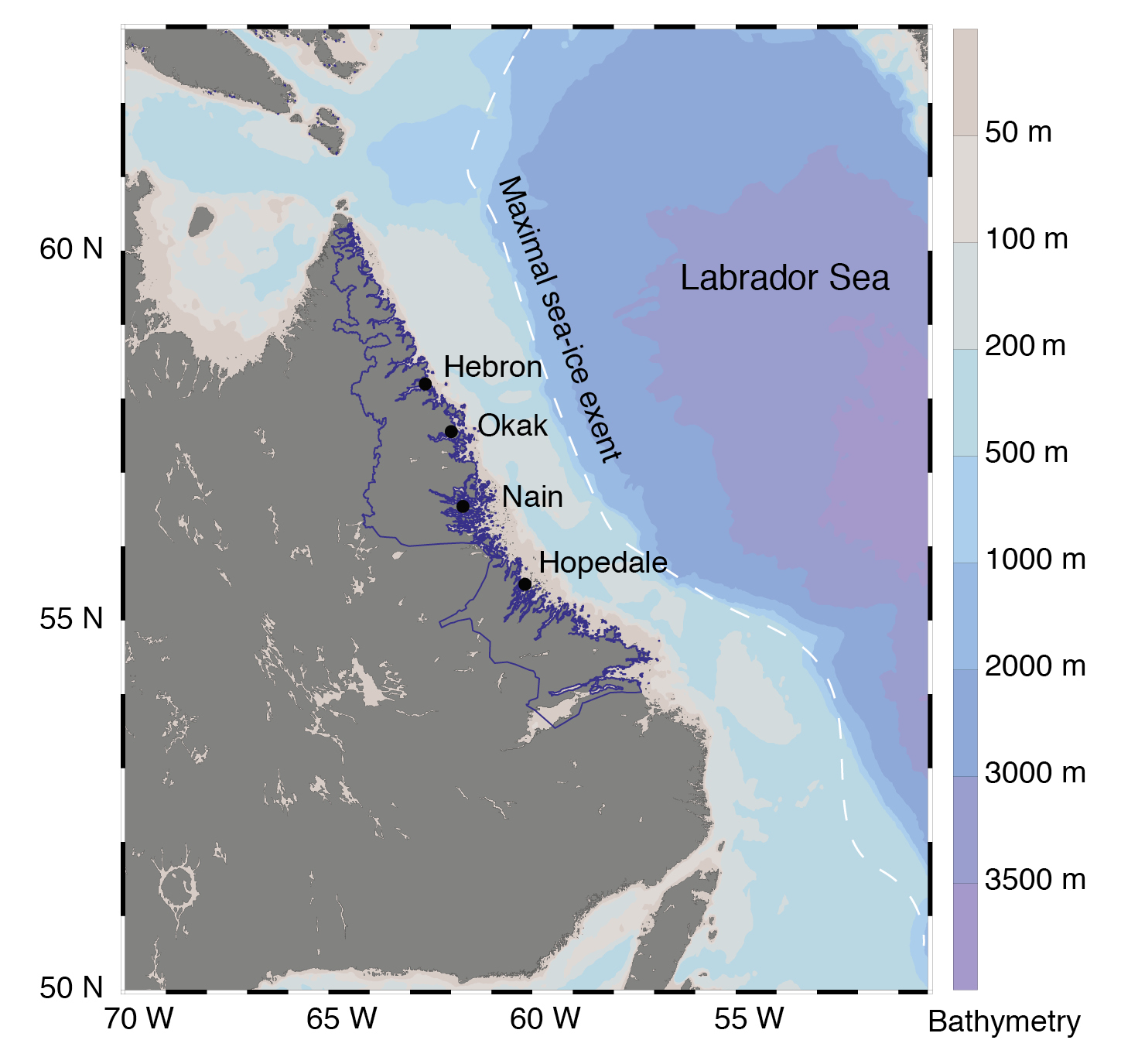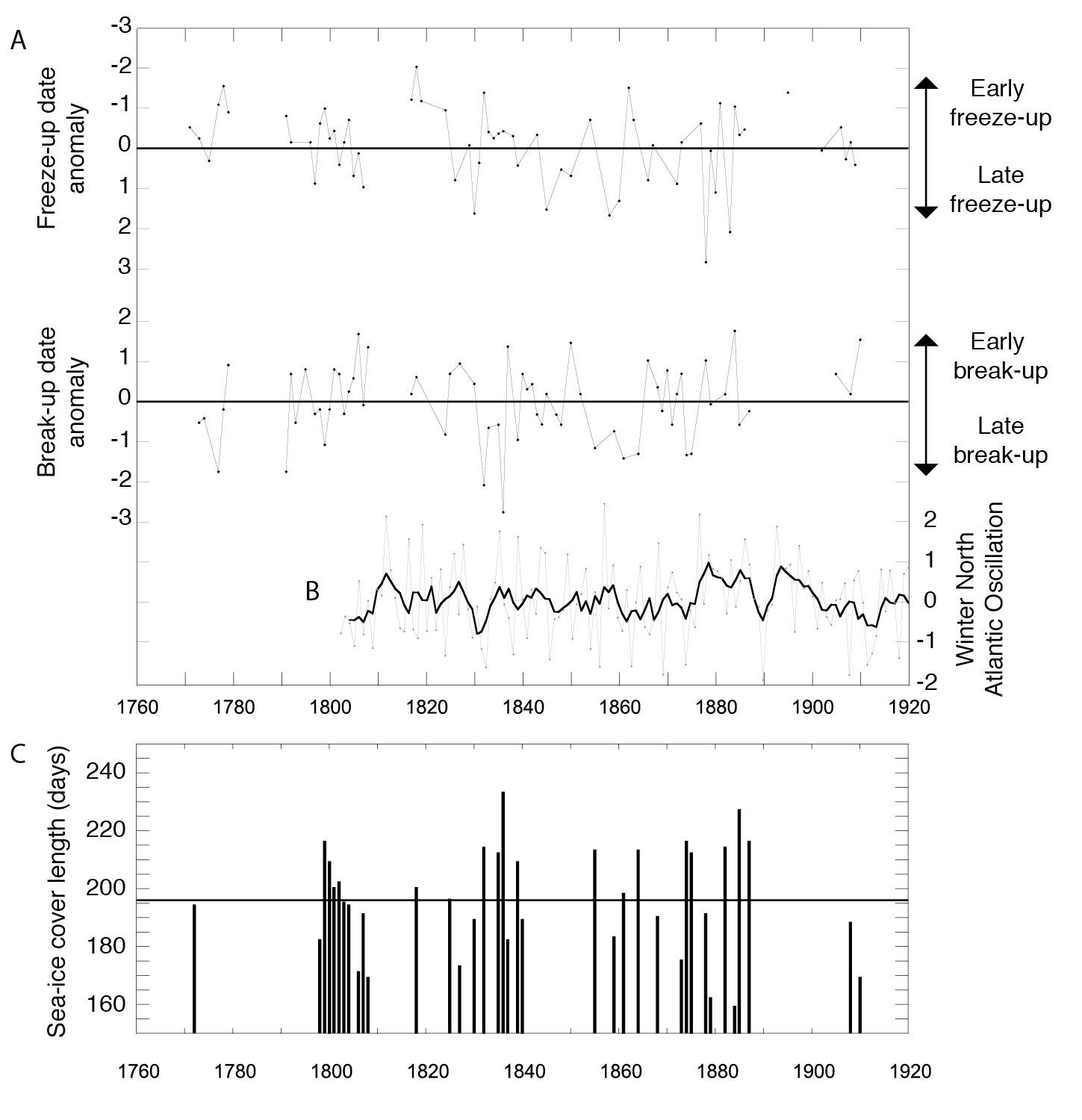- Home
- Publications
- PAGES Magazine
- Winter Freeze-up and Summer Break-up In Nunatsiavut, Canada, From 1770 To 1910
Winter freeze-up and summer break-up in Nunatsiavut, Canada, from 1770 to 1910
Ouellet-Bernier M-M & de Vernal A
Past Global Changes Magazine
28(2)
52-53
2020
Marie-Michèle Ouellet-Bernier1 and Anne de Vernal2
Historical sources provide unique information on sea ice in a coastal Labrador Sea region. Data extracted from missionary journals permit differentiation of the winter and summer signals. Decadal variations marked winter conditions during the 19th century.
Snow and ice are fundamental in the description of subarctic and Arctic environments. In Nunatsiavut, the autonomous territory of the Labrador Inuit, the land-fast ice forms seasonally along the coast. It is considered as an extension of the land. Land-fast ice is thus very important for cultural activities, communications, mobility, and livelihood (Cuerrier et al. 2015). Usually, land-fast ice forms in mid-December and ice breaks up in mid-June, while drift ice can remain along the coast until late July (Canadian Ice Service 2013; Fig. 1). The historical sources provide punctual information that may help to document the natural variability of sea-ice freeze-up and break-up during the 19th century and before. Attention is specifically directed towards written sources.
 |
|
Figure 1: Map showing the location of sites mentioned in the text and the maximum extent of sea ice as recorded from satellite imagery in March 2019 (National Snow and Ice Data Center, nsidc.org). Nunatsiavut territory is delimited in blue. |
Human occupation
Dorset people arrived from the Central Arctic and settled along the Labrador coast about 650 BCE. They depended on marine resources, and their presence in a region is often associated with extended sea ice (D’Andrea et al. 2011). Migrating from Alaska, the Thule colonization of Labrador began much later, around 1200 CE. It is likely that both Dorset and Thule cultures occupied the Labrador coast from about 1200 to 1500 CE. The Dorset group occupation ended at about 1500 CE; the reason for their disappearance is still unclear. It could be linked to warmer climate and more variable sea-ice conditions, or to competition with the Thule (McGhee 1997). During the 17th century, a transition occurred from Thule to Inuit culture (Kaplan and Woollett 2000). Moravian missionaries established their first mission station in Nunatsiavut in 1770 and started to document their environment and keep written archives (Demarée and Ogilvie 2008). On 18 September 1771, they noted: "In December all is frozen far out to sea and the ice remains until June, or even until July, for they all go wes[t]" (Nain Diary 1771).
Sea-ice freeze-up and break-up
The first record of freeze-up and break-up dates was extracted from Nain Diaries encompassing the period 1771–1808. A transcript is held at the Them Days archive center in Happy Valley-Goose Bay, Labrador. In addition to direct mention of winter freeze-up, the first hunt on ice is considered to be an indicator of ice presence. A correction to the estimate of freeze-up dates was made by taking into account the fact that based on the historical data, the first hunt took place on average five days after the ice formed. The first kayak arrival was taken as an indicator of ice break-up in summer. Here, too, a correction was applied, as the first kayak arrived on average seven days later.
The second set of data was extracted from the Moravian Periodical accounts spanning 1816–1910, which were presented as yearly reports to the Moravian Church headquarters in London (Fig. 2). Freeze-up and break-up dates were noted in Hopedale, Nain, Okak, and Hebron (located at latitudes of 55° to 58°N; Fig. 1). Additional comments regarding exceptional situations were also made. Freeze-up and break-up dates have been standardized for each village in order to remove local climate effects (Fig.2). The duration of sea-ice cover was calculated from freeze-up and break-up dates when both were available. From 1771 to 1910, the mean freeze-up date was 5 December, ranging from 27 October to 10 January; the mean break-up date was 19 June, ranging from 30 May to 20 July. The mean length of sea-ice season represents a total of 196 days (28 weeks; Fig. 2).
Early freeze-up and late break-up dates were recorded from 1770 to 1810, which corresponds to the end of the "Little Ice Age" (D'Arrigo et al. 2003). Then, a warming trend was observed from the beginning of the 19th century. From 1800 to 1810, break-up anomalies showed a positive trend, representing early break-up dates. Early sea-ice formation was recorded from 1817 to 1824, whereas thaw occurred in early summer. An asynchronous pattern was observed again between 1839–1848 and 1855–1864 with late freeze-up and late break-up. From tree-ring density records, D'Arrigo et al. (2003) suggested that the increase in climatic variability during the first half of the 19th century was accompanied by the occurrence of extreme conditions. From 1865 to 1885, variations between late freeze-up/early break-up and early freeze-up/late break-up resulted in shorter sea-ice cover duration in some years and longer in others (Fig. 2). Afterwards, and until the 20th century, there was almost no mention of ice freeze-up and thaw. The Nunatsiavut population was severely affected by epidemic and food scarcity; therefore, Moravians reported on the humanitarian situation instead of climatic parameters (e.g. Periodical accounts 1895, vol. 3, no. 25).
A unique window into past winters
The first standardized instrumental winter temperature measurements were made in 1880 (First International Polar Year initiative; Demarée and Ogilvie 2008). The use of historical sources is thus very valuable as it provides an overview on winter conditions before 1880. It is rarely possible to reconstruct winter climate conditions from proxy sources such as tree-ring data, which mostly represent spring and summer (e.g. D'Arrigo et al. 2003). Along the Labrador coast, the sea-ice freeze-up relates to atmospheric and oceanic conditions. Early freeze-up is usually associated with cool temperatures and fresh surface waters in the summer and early autumn (Close et al. 2018). The freeze-up date varied independently from the summer break-up date. The retreat of sea ice usually relates to advection of warm air masses from the south with strong southerly winds (Crane 1978). Summer break-up dates must be used carefully as remaining drift ice along the coast can induce a bias in observation. Strong dominant northwesterly winds can block the Labrador coast with ice for a longer period (Banfield and Jacobs 1998). From long-term observational data, Walsh et al. (2017) demonstrated that Arctic sea-ice variations are driven by air temperature, wind forcing, radiative forcing, and ocean heat fluxes.
Intra- to multi-annually resolved information
Historical sea-ice information offers the possibility to develop records with intra-annual temporal resolution and to provide both summer and winter perspectives on climate states. However, multiple years are missing in the historical records, as missionaries do not always refer to climate in the periodical accounts.
A relationship between winter temperature and sea-ice cover in the Labrador Sea/Baffin Bay area and the North Atlantic Oscillation (NAO), which is calculated from the surface sea-level pressure difference between the Azores and Iceland, was supported by Hurrell and Deser (2010). In our study, winter freeze-up shows large amplitude variations, which might be linked to the NAO. Winter NAO was in a positive mode during the 1830s, which corresponds to enhanced sea-ice duration and extent, and a low sea-surface temperature. Our calculations indicate that sea ice was present more than 200 days per year in 1831, 1834, 1835, and 1838.
Outlook
From 1770 to 1810, freeze-up and break-up dates show long sea-ice seasons characterized by both early freeze-up and late break-up. From 1816 to 1880, the length of the sea-ice season varied considerably, with the freeze-up and break-up dates showing no relationship. From 1875 until the early 20th century, a trend to later freeze-up in winter and earlier break-up in summer is observed, which probably results from regional climatic warming. As winter temperature data are typically not available from natural proxies such as tree-rings, historical data from written sources offer a unique perspective on winter and summer onset in Nunatsiavut dating back to 1770.
affiliations
1Institute of Environmental Sciences, University of Quebec in Montreal, Canada
2Department of Earth and Atmospheric Sciences, University of Quebec in Montreal, Canada
contact
Marie-Michèle Ouellet-Bernier: ouellet-bernier.marie-michele courrier.uqam.ca
courrier.uqam.ca
references
Banfield CE, Jacobs JD (1998) Can Geogr 42: 354-364
Close S et al. (2018) Clim Dyn 51: 2485-2508
Crane RG (1978) Arctic 31: 434-447
Cuerrier A et al. (2015) Hum Ecol Interdiscip J 43: 379-394
D'Andrea WJ et al. (2011) Proc Natl Acad Sci USA 108: 9765-9769
D'Arrigo R et al. (2003) Clim Dyn 20:219-228
Demarée GR, Ogilvie AEJ (2008) Clim Change 91: 423-450
Hurrell JW, Deser C (2010) J Mar Syst 79: 231-244
Jones PD et al. (1997) Int J Climatol 17: 1433-1450
Kaplan SA, Woollett JM (2000) Arct Antarct Alp Res 32: 351-359
McGhee R (1997) In: Gilberg R, Gullov HC (Eds) Fifty years of Arctic research: Anthropological studies from Greenland to Siberia. Cambridge Univerity Press, 209-213
Nain Diaries (1771-1808). Brethren's Society for the Furtherance of the Gospel, English Translation. Housed at Them Days, Happy Valley-Goose Bay, Labrador, Canada. Original manuscript in German can be found at the Unity Archives of Herrnhut.
Walsh JE et al. (2017) Geogr Rev 107: 89-107
additional resource
Canadian Ice Service (2013). Environment Canada:

